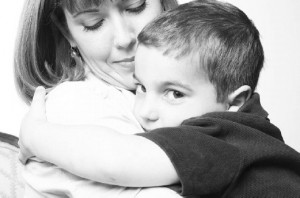By Margaret Chuong-Kim, MA
 Among parents of infants these days, there is constant debate about how to respond to a baby’s cries. On one hand, there are proponents of the “cry it out” method, where the baby is left alone to cry in the hopes that he or she will eventually stop. On the other hand, there are the attachment parents who respond immediately to their crying babies and attempt to soothe them using various methods including holding and cuddling. While the cry-it-out (CIO) method has been popular in previous years, Attachment Parenting (AP) is gaining a foothold among new parents today. Results of studies in psychology indicate the AP approach to crying is most likely to result in an emotionally and physically healthy child.
Among parents of infants these days, there is constant debate about how to respond to a baby’s cries. On one hand, there are proponents of the “cry it out” method, where the baby is left alone to cry in the hopes that he or she will eventually stop. On the other hand, there are the attachment parents who respond immediately to their crying babies and attempt to soothe them using various methods including holding and cuddling. While the cry-it-out (CIO) method has been popular in previous years, Attachment Parenting (AP) is gaining a foothold among new parents today. Results of studies in psychology indicate the AP approach to crying is most likely to result in an emotionally and physically healthy child.
The Origins of AP
Attachment Theory originated in the late 1960s, when psychologist John Bowlby postulated that a warm, intimate relationship between caregiver and infant is necessary for optimal health as well as for basic survival. As such, each individual is born well-equipped with reflexes and instincts for interacting with a primary caregiver, which is often the mother. For example, infants quickly learn to recognize and prefer both their mother’s voice and smell. As babies develop some locomotor control, they display their desire to be close to their caregivers by reaching toward their mother or father to be picked up or by crawling toward them. From an evolutionary perspective, these behaviors have survival value. Babies who lack such attachment behaviors will stray from their caregivers and are more likely to get lost, attacked, and perish. An infant’s cry is also intended to increase the likelihood of its survival, as a mother’s instinct is usually to go to her child at the first sign of distress.
We live in an age where we can know that the baby is safe in another room, despite the loudness of his cries. Does this mean we should leave babies to cry on their own? CIO proponents often advise that babies left to cry will eventually stop, and the duration of future crying bouts will decrease. What are the emotional consequences of crying for the infant when she is left unattended? Bowlby and colleagues initiated a series of studies where children between the ages of one and two years old who had good relationships with their mothers were separated from them and left to cry it out. Results showed a predictable sequence of behaviors:
- Protest consists of loud crying and extreme restlessness.
- Despair consists of monotonous crying, inactivity, and steady withdrawal.
- Detachment consists of a renewed interest in surroundings, albeit a remote, distant kind of interest.
Thus, it appears that while leaving babies to cry it out can lead to the eventual dissipation of those cries, it also appears that this occurs due to the gradual development of apathy in the child. The child stops crying because she learns that she can no longer hope for the caregiver to provide comfort, not because her distress has been alleviated.
AP and CIO Effects on the Amount of Crying
Do babies cry more when they are attended to? A 1986 study concluded just the opposite: The more a mother holds and carries her baby, the less the baby will cry and fuss. Cross-cultural studies also show that parents in non-Western societies are quicker than parents in Western societies to respond to their crying babies, and babies in non-Western societies cry for shorter spans of time. Caregivers in 78% of the world’s cultures respond quickly to an infant’s cries. For instance, Efe caregivers in Africa respond to a baby’s cries within ten seconds at least 85% of the time when the baby is between three and seven weeks old, and 75% of the time when the baby is 17 weeks old. !Kung caregivers respond within ten seconds more than 90% of the time during the baby’s first three months, and more than 80% of the time at one year old. In contrast, American and Dutch caregivers have been found to be deliberately unresponsive to an infant’s cries almost 50% of the time during the baby’s first three months. Infants in non-Western societies have been found to fuss just as frequently as those in Western societies, but due to the prompt response of caregivers in non-Western societies, the overall cumulative duration of crying is less than what occurs in Western societies.
How AP Works
According to Attachment Theory, many babies are born without the ability to self-regulate emotions — that is, they find the world to be confusing and disorganized, and do not have the coping abilities required to soothe themselves. Thus, during times of distress, they seek out their caregivers because the physical closeness of the caregiver helps to soothe the infant and to re-establish equilibrium. When the caregiver is consistently responsive and sensitive, the child gradually learns and believes that she is worthy of love and that other people can be trusted to provide it. She learns that the caregiver is a secure base from which she can explore the world, and if she encounters adversity, she can return to her base for support and comfort. This trust in the caregiver results in what is known as a secure individual.
Children who do not have consistently responsive and sensitive caregivers often develop into insecure individuals, characterized by anxious, avoidant, and/or ambivalent interactions. Long-term studies have shown that secure individuals, compared to insecure individuals, are more likely to be outgoing, popular, well-adjusted, compassionate, and altruistic. As adults, secure individuals tend to be comfortable depending on others, readily develop close attachments, and trust their partners. Insecure individuals, on the other hand, tend to be unsettled in their relationships, displaying anxiety (manifesting as possessiveness, jealousy, and clinginess) or avoidance (manifesting as mistrust and a reluctance to depend on others). North American parenting practices, including CIO, are often influenced by fears that children will grow up too dependent. However, an abundance of research shows that regular physical contact, reassurance, and prompt responses to distress in infancy and childhood results in secure and confident adults who are better able to form functional relationships.
The Dangers of CIO
It has been suggested in the past that CIO is healthy for infants’ physical development, particularly the lungs. A recent study looking at the immediate and long-term physiologic consequences of infant crying suggests otherwise. The following changes due to infant crying have been documented:
- Increased heart rate and blood pressure
- Reduced oxygen level
- Elevated cerebral blood pressure
- Depleted energy reserves and oxygen
- Interrupted mother-infant interaction
- Brain injury
- Cardiac dysfunction.
The study’s researchers suggested that caregivers should answer infant cries swiftly, consistently, and comprehensively — recommendations that are in line with AP principles.
CIO or AP as a Matter of Perception
CIO supporters tend to view their infants’ cries as attempts to manipulate caregivers into providing more attention. Holding this view can be detrimental to the immediate and long-term health of the baby. In the field of cognitive psychology, there exists the premise that our thoughts underlie our behavior. Thus, if we think positively about an individual, our behaviors toward them tend to be positive as well. Conversely, if we think negatively about an individual, we will behave correspondingly. Consider people in your own life whom you consider manipulative — how does that perception influence your behavior toward them? It is unlikely that the interpretation of a manipulative personality will result in the compassionate, empathetic, and loving care of that individual. Infants, quite helpless without the aid of their caregivers, may suffer both emotional and physical consequences of this type of attitude.
When faced with a crying baby, it may be prudent to ask yourself the following questions: Why am I choosing this response? Do I want my baby to stop crying because he feels comforted and safe, or do I want my baby to stop crying for the sake of stopping crying? What is my baby learning about me and the world when I respond in this manner? If I was a baby and was upset, how would I want my caregivers to respond?
Reprinted with permission from http://drbenkim.com.



 All babies cry. And all parents are continually striving to find the best way to respond to those cries.
All babies cry. And all parents are continually striving to find the best way to respond to those cries.